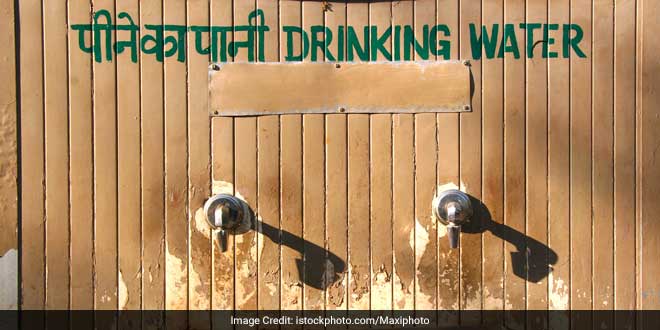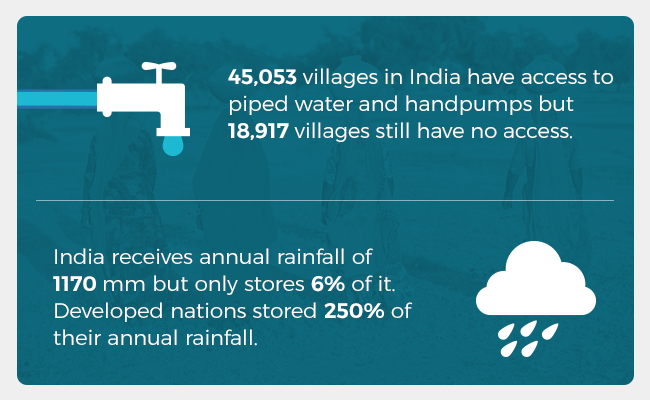Highlights
- India is heading towards an unmanageable water crisis
- By 2030 India will have a water deficit of 50 per cent
- River pollution and poor storage infrastructure main reasons for scarcity
Bharat from Sunder Nagri in East Delhi has a weighty kit bag which he carries around and opens alongside water taps in the area. Every day, he collects water from the taps and begins testing it for impurities. A part of ‘Youth User Group’ first set up in 2012 by Action India in Sunder Nagri with support from WaterAid India, Bharat utilizes his water testing kit to determine if the water is safe for drinking or not.
Unfortunately, millions of Indians across the country are not equipped with such facilities to test whether the water consumed and used by them is safe enough or not. The dual problems of not having access to water, or having access to unsafe water have resulted in safe and hygienic water, a basic amenity becoming a luxury.
While drinking water, people usually check if the water is clear. If it looks clean, they assume that it is safe to consume. But this is often not the case. Water looking clean might not be always safe, Bharat says.
Access to safe drinking water has been a grave problem for India, especially in rural areas where lack of usable water has resulted in decades old sanitation and health problems.
Government records show that in 1980, just 1% of India’s rural areas had access to safe, usable water. By 2013, that had increased to 30%, but the majority of rural India continues to live without proper access to safe drinking water.
A WaterAid report in 2016 ranked India among the worst countries in the world for the number of people without safe water. An estimated 76 million people in India have no access to a safe water supply, and the situation is only getting more serious.
The Asian Development Bank has forecast that by 2030, India will have a water deficit of 50 per cent. The Union Ministry of Water Resources has estimated the country’s current water requirements to be around 1100 billion cubic metres per year, which is estimated to be around 1200 billion cubic metres for the year 2025 and 1447 billion cubic metres for the year 2050.
With a projected population growth of 1.4 billion people by 2050, the total available water resources would barely match the total water requirement of the country.
India is not a water scarce country. Along with having major rivers, we receive an average annual rainfall of 1170 millimeters. But lack of sensitisation with regard to both conservation of water and pollution of water sources has resulted in a large part of the population for whom water has become more of a curse than a boon. Infrastructure for storage of water must be developed properly to ensure that people have access to safe water across the country, said Dr. Narayan G. Hegde, Trustee of the BAIF Development Research Foundation and author of the report ‘Water Scarcity in India.’
Polluted Rivers, Shrinking Access To Water
Water supply in India has two principal sources, namely water from rivers and groundwater. However, the rivers are shrinking because of pollution and industrialization, while the population keeps growing, pushing us towards an enormous water deficit.
Rampant pollution, dumping of sewage waste and abuse of the rivers has led to large sections of important rivers like Ganga and Yamuna becoming unfit for use. Take for instance, the Ganga, which flows through 11 states of India and provides water to more than 500 million people.
Many parts of the Ganga in Bihar and Uttar Pradesh have become completely unfit for use because of incessant waste disposal, ranging from dead bodies and to industrial waste. Earlier the water in many parts of these two states could be consumed and used for other purposes, but pollution has rendered the river water completely useless, said Vikas Chandra, an activist who has been campaigning for a pollution free Ganga for the last 19 years.
Vikas, who has spent nearly all his life near the banks of the river in Patna, says that the gradual decay in the quality of the water due to pollution over the years has created a deficit between the population and the volume of clean river water they have access to.
Safe drinking water, a basic amenity has become a luxury in many Indian households, especially in semi-urban and rural areas. Official figures show that each day, approximately 500 million litres of wastewater from industrial sources is dumped into the Ganga. The Yamuna, similarly receives 850 million gallons of sewage every day from Delhi alone. For those who are dependent on groundwater sources, the presence of arsenic in the eastern belt in the Ganga-Brahmaputra region poses equally dangerous threats.
Arsenic is a major problem, especially for people residing in the Ganga-Brahmaputra belt in eastern India. Arsenic laden water has many adverse health effects and affects over 900 million people in India. With India’s rivers becoming more polluted with every passing day, the dependency on groundwater resources is increasing. But steps must be taken to ensure that people do not end up using arsenic laden water, as that would be more harmful than beneficial, said K.B. Biswas, Chairman, Central Ground Water Board.
Several initiatives have been undertaken to deal with the water crisis looming ahead of India, both by government and non-government bodies. In 2014, the 20,000 crore Namami Gange program was announced by the Union Government. It is a holistic program that not focuses on cleaning the Ganga, along with setting up biodiversity centers, crematoriums and toilets along the river banks to reduce pollution in the river.
Looking for water solutions beyond rivers
Cleaning up rivers is not the only solution India should look at, as rainwater and groundwater resources of India are also facing risk.
Data collected from the Ministry of Drinking Water and Sanitation states that 45,053 villages had access to piped water and handpumps by the end of 2016-17, accounting for 64.19 per cent of India. Almost 19,000 villages across the country still do not receive regular water supply.
In 2015, a report by the Ministry of Water Resources, River Development and Ganga Rejuvenation stated that though India receives an average annual rainfall of 1170 mm, poor storage infrastructure allows it to store only 6 per cent of rainwater, compared to 250 per cent stored by developed nations.
Rainwater storage and harvesting is still not a regular practice in India. In 2001, the Tamil Nadu government made it compulsory for each household to have rainwater harvesting infrastructure and the results reflected in the improvement of overall water quality within 5 years. A similar experiment has been tried out in the cities of Bangalore and Pune, where housing societies are required to harvest rainwater. However, apart from these few examples, there is no pan India infrastructure for rainwater harvesting. It is important to empower local people and enable them to save water for usage.
The key is to look at securing drinking water and the role communities play in doing so. We are working to promote locally owned and managed drinking water security plans which are simple and can be used, monitored and managed by people and local governments, said Avinash Kumar, Director Program and Policy, Water Aid.
While ambitious government projects like the Namami Gange are slowly sowing the seeds of cleanliness on the river front, non-governmental bodies like WaterAid are reaching out to people, especially in semi-urban and rural areas where water scarcity can reach unmanageable proportions. By providing water testing kits, rainwater harvesting solutions and alternate water supply systems such as development of surface water, WaterAid is providing accessibility and storage solutions for available water resources.
With continuous efforts by both government and non-government bodies to improve the water situation in India, undoubtedly improvements have been achieved with regard to water accessibility. For such efforts to yield continued results, the focus on cleaning India’s major water bodies as well as proper management of rain and surface water resources should be further prioritised.
Also Read: A Woman Paddle-boards Across The Ganges To Spread The Swachh Message

























































Pawan Kakkar
August 7, 2017 at 8:24 am
Grassroot level solutions coupled with an incentive programme from the Governments at the centre, state, city and panchayat level are now necessary to harness the rainwater in its purer state as it falls.
While we are struggling to spread awareness about Rain Water Harvesting , a lot of work has been done in the area concerning rain water conservation, globally. Green infrastructure can be easily inserted under our urban paved areas to collect, pre treat and store rainwater in a localised manner. When our rivers are filled with filth, what other than pollution can be provided to the runoffs in these channels, cleaning it back has been a challenge which shall only become enormous.
The elevated roads can become a boon for water starved areas, if we commit some early investments to trap that water before it shall marry the sewage in the stormwater drains. Underground, online flow separation technologies from FRANKISCHE can deliver cleaned storm water devoid of silt, light oils and most of the heavy metals into underdrained swales.
Most of us might think that we still have time to resurrect the natural water cycle, alas, there isn’t much of it.
Amol
January 1, 2018 at 1:22 pm
It makes me worry; Population of 1.2 billion and very limited clean water resources.
I am An Enthusiast and owner of intothewild.in website (Still to be developed)
We are gonna travel places to search fresh clean and Natural waters around all over in India.
We went to Satara and had collected Water samples from 2 waterfalls which had a TDS meter readings between 16 – 20 Ppm.
Kindly have a look at our video. And let me know if I can be of any help.
https://youtu.be/ZZ34Mrh00Tw
Arvind Samuel
October 2, 2018 at 4:39 pm
Dear Sir/Madam
greetings, I an Arvind Samuel from Jhansi UP and director of an NGO Deliverance Outreach Ministries DOM. We are preparing a project Proposal on safe drinking water for India and we need to use some of the content from your respected above program swatch India campaign, kindly allow us or permit us to use them in the name of, data from Banega swatch India program of ndtv.
Hope to hear from you soon.
thanking you
yours faithfully
Arvind
Gautam Tagore
June 27, 2019 at 5:36 pm
Ocean Water
Although ocean water makes up nearly 97 percent of all water on earth, it is not a viable source of potable water unless salt and other impurities are removed. Desalination, the process by which salt is removed from water, is a rapidly growing practice. While salt and other microscopic particles can be removed from water in a variety of ways, the most promising method is through reverse osmosis. This process forces saltwater through filters with microscopic pores that remove salt and other microbes. Reverse osmosis requires large amounts of energy, making it a very expensive process.
HnG Com
April 2, 2021 at 12:07 am
We are into making water potable and pathogens free. The product can be used to treat STP based water, water comming from Rain water harvesting.